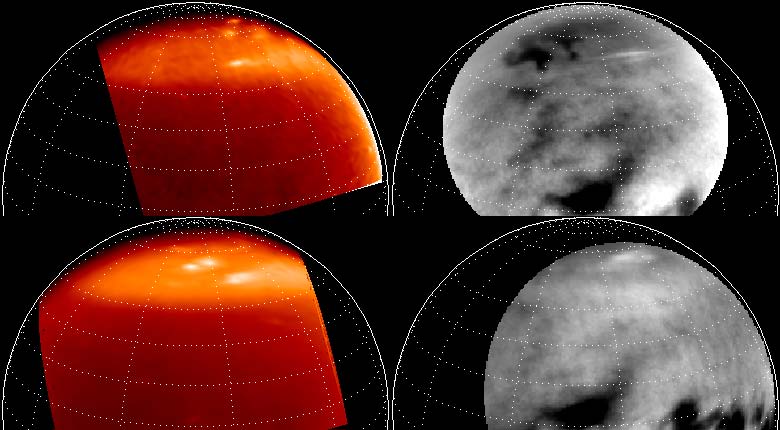[/caption]
While browsing through Cassini images of Saturn’s moon Titan, astronomer Mike Brown and some colleagues noticed a recurring pattern of clouds appearing over the frigid moon’s north pole. While a large, stable cloud has been visible in every image of Titan’s north pole obtained since its discovery, Brown noticed bright “knots or streaks” in the cloud that appeared on some images but not others, or changed in images taken hours apart. Brown thought these bright features looked similar to cumulus clouds – or even like thunderheads. But how could tropical-like thunderheads be present on a moon where surface temperatures hover around -178°C (-289°F)? Brown believes these clouds are similar to winter-time lake-effect clouds found on Earth, and are due to convection and condensation occurring in the methane and ethane lakes on Titan.
“On the Earth, lake-effect clouds occur in the winter when cold air goes over warm water (like the Great Lakes) and picks up heat and moisture and then, often, deposits it all in the form of snow on the eastern shores,” Brown told Universe Today. “On Titan the winters are so long (the north pole has been in the dark for the past ~10 years!) that the lakes retain almost no heat. But as the spring sunlight starts to hit the lakes they begin to heat up just a tiny amount and this is enough to cause little blips of evaporation and clouds.”
So, while lake-effect clouds on Earth are predominantly a winter event, on Titan, lake-effect clouds occur as spring is approaching. The clouds appear only in images taken since February 2005, as the increasing amount of sunlight has heated the liquid hydrocarbon lakes slightly and evaporation takes place. “Every time the lakes warm up just a bit, a huge dollop of evaporation occurs, which re-cools the lake, and we see a cumulus cloud pop up. The lake then has to wait for some more sunlight before it happens again,” Brown wrote in his blog.
Brown, a professor of planetary astronomy at Caltech, is known primarily for his discoveries of trans-Neptunian objects like Eris and Sedna. But he enjoys dipping his toes in the water, so to speak, in other areas as well. That includes studying the meteorology of a moon that’s over 1,200 million kilometers away. “I think it’s pretty fun,” Brown admitted.
Since spring is approaching on Titan (equinox occurs in August 2009), the cloud activity is likely to increase. Fortuitously, Cassini is scheduled to fly by Titan frequently the next few years, and Brown and his team will be keeping an eye on these lake-effect-like clouds that may have a great influence on Titan’s weather.
“When Cassini was first conceived no one even knew that clouds existed on Titan!” said Brown. “But the trick is to put a spacecraft up that has highly versatile and flexible instruments and then you’ll be able to see things even if you hadn’t anticipated them.”
Brown and his team examined the north polar clouds of Titan using data from VIMS (Visible and Infrared Mapping Spectrometer) and ISS (Imaging Science Subsystems) instruments on board the Cassini spacecraft and from adaptive optics observations from the Gemini observatory and full-disk spectroscopy of Titan from the NASA Infrared Telescope Facility (IRTF).
Titan continues to surprise planetary scientists like Brown. “I love the similarities and differences with the Earth,” he said. “Titan is the only other place that we know of that has both liquids on its surface and a thick atmosphere, so we get a chance to watch something sort of Earth-like but with some very non-terrestrial behavior.”
Source: arXiv


“a moon that’s over 1,200 billion kilometers away.” – Must have moved…….
Nice article otherwise 🙂